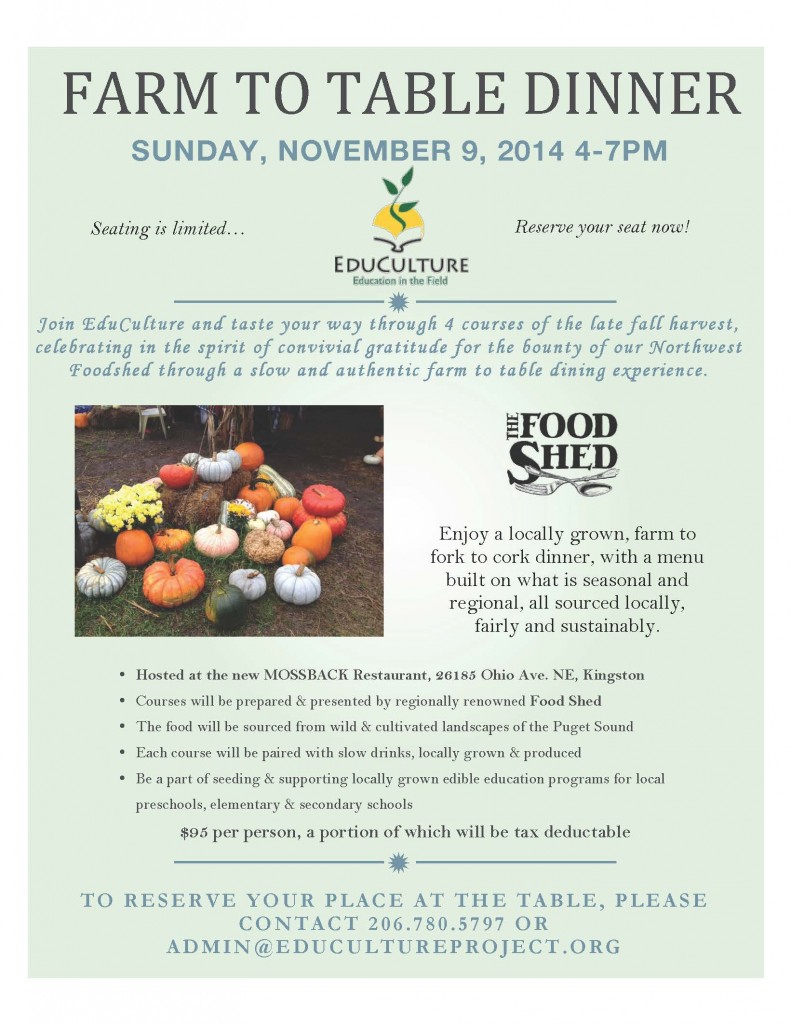Did You Know you could Compost those Fall Leaves Too?
November 7th, 2015
Food scraps and decomposing plants from your spring and summer garden are fantastic compost material, but there’s something else–something better–that we’ve been missing all along: tree leaves. At least twice as rich in minerals than manure, the composted leaves of most trees can save you cash, not only on what you would spend on plant food and humus, but also on sanitation bills.
Some of you may be thinking, Well, I already save on bills by burning my leaves. But think of the carbon footprint you create when burning that organic material. Plants absorb carbon dioxide and release oxygen as they grow, storing the carbon dioxide in plant material that is rereleased as the plants burn. Even though composting also releases small amounts of carbon, much of it is contained in the decomposing plant matter. A major contributor to climate change and airborne pollutants, carbon dioxide is a greenhouse gas that contributes to the greenhouse effect, which adds “insulation” to the earth, making our planet warmer.
During extra hot summer months that often go unaccompanied by rain, your mineral-rich leaf compost will improve depleted and dry soil, helping your garden reach its full potential. Plant material from trees, ranging from leaves to pine needles, are high in mineral content such as calcium, magnesium, nitrogen, and phosphorus–many of which make up your average bag of garden compost or potting soil. This is because most trees are deep-rooted, absorbing minerals from deep within the earth that travel through the tree and into the leaves. The structure of these leaves as they decompose, known as humus, facilitates mineral filtration, soil consistency, and overall plant and soil health by aerating heavy soils, preventing sandy soils from drying, and balancing water levels in the soil.
In order to successfully compost leaves, one must do a bit more than rake them into a pile and check on the pile come springtime. Adding nitrogen—such as manure—to the pile will allow the compost to heat up and give the bacteria in the compost something to break down. Next, attempt to grind or shred your leaves. This will make handling the compost much easier, as the humus will be more broken-down. Turn the compost pile every three weeks and, come spring, use your new compost as mulch for a healthy garden and healthy harvest!
For more information on other things you can use for compost, check out this detailed composting chart that lists materials ranging from dog poo to algae.
Contributed by Christine St. Pierre
The Medicine Chest: Interview with Local Herbalist and Entrepreneur
October 22nd, 2015

Nora Harrington and her close friends are asking communities to rethink their medicine cabinets, bringing herbal remedies directly to your door. She and I shared a cup of virtual tea and chatted about her herbalism passion, entrepreneurial journey, and the love and intentions behind her recent endeavor, Medicine Chest Herbs. Pull up a chair and join us.
Christine St. Pierre: Starting a business on your own takes great planning, passion, and grit. What about herbalism moved you so deeply that you took it upon yourself to bring it to others?
Nora Harrington: Aw. Such a sweet question. Thanks for seeing that!
In my early twenties, I was pretty sick. I did my own research and found some great healers to help me, but a lot of the alternative modalities I wanted to try were just out of my budget (i.e. acupuncture and naturopathy). I had always been studying herbs and alternative health, but it wasn’t until a friend gave me a bottle of homemade bitters that I really got a taste of Western or Folk Herbalism. They cured me! Those bitters helped me so much. And I was astonished that I could go out and make my own batch after. I started cooking up a storm of herbal medicine and I felt deeply inspired by the accessibility and effectiveness of this medicine. Soon afterward, I enrolled in Herbalism School in Portland, and the rest is history.
When we were doing the first herb CSA, we got a lot of feedback from people that we were helping them learn about herbs, and I found that really inspiring, too. I started this business because I truly believe that the medicine we need is right outside our door, and that plant medicine belongs in our homes. It is an “accident” of the current culture that we do not automatically inherit a basic knowledge of how to heal ourselves with herbs and food. That’s why our little tagline is “Grandma Knows Best.”
St. Pierre: How did the seed for Medicine Chest Herbs become planted and grow into fruition?
Harrington: The idea for an herbal remedies CSA landed in my brain almost 4 years ago. My dear friend Heather Wolf and I were planning to attend herb school, but we needed to raise money. I had just started to make remedies at home and I had been giving them out to friends and family members, and I thought, “Why don’t I sign people up for this ahead of time?” So Heather and I started Remedies CSA called The Wheel Plant Medicine. We ran it for a year and had a wonderful time, holding some classes and herb walks, too. It helped us pay for school.
Then, after traveling to Europe two years ago, I decided I wanted to start the project again, but in a more financially viable way. (The Wheel had been all donation based.) I had the idea this time to partner with other small-scale herbalists; by finding other people to make the medicine, I could focus on curating the shares and creating the educational zine that comes with them. The zine is a great way for me to make art in the name of empowering people to heal themselves with herbs. It has been really rewarding.
Mirabai “The Magician” Troll is my business partner. Starting this project was overwhelming–I had never had a real business before and there were so many things that my witchy artist brain could short circuit on. Mirabai came on initially as “Head of the Problems Department,” but pretty soon after that joined the Medicine Chest as a partner. She now edits and contributes to the zine, runs most of our marketing, and generally makes the magic happen when it is most needed.
St. Pierre: How did you gather knowledge on herbalism?
Harrington: The bulk of my formal education was carried out at the School of Traditional Western Herbalism in Portland, which I attended for a year. Before that, I did an internship with an addiction rehabilitation center in Peru, where they use and sell to the public about 50 different medicinal herbs. In addition to various additional jobs and conferences, I continue learn from our participating herbalists.
St. Pierre: Say I’m a potential customer (because I am). How does the Medicine Chest work?
Harrington: Essentially, you order a package of herbs, and then, at the beginning of the next season, we send you the package, which is pretty much a treasure trove I must admit. If you live on Bainbridge, we will deliver it to your home. If you live in Seattle, you can also chose to pick up your share at the SugarPill on Capitol Hill.
So, you go to the website (www.medicinechestherbs.com). There, you have some options:
1. You can get a Full Share, which is a package 6 remedies and one Zine per season. If you buy the full share for the whole year—as in, you pre-order all four shares for the whole year—you save a little money. But you could also just buy the full share for the upcoming season, which in this case is winter.
2. Another option would be to buy a Half Share. The half share contains 3 items and one zine per season. Same deal here. You could get the Half Share for the whole year—all four half shares ordered at once—and you get a little discount. Or, you can get the half share for the upcoming season, which is around $39.
We also sell an Essentials Pack, which is a package of our most trusted remedies. It also comes with a little informational zine. Additionally, we sell a subscription to the zine only as well as individual products from the shares (all on the site). The zine is a place where I feel like I’m able to bring together a lot of different perspectives and tips on at-home herbalism.
St. Pierre: What are your intentions with the Medicine Chest?
Harrington: Our hope is for the Medicine Chest to continue on as a beacon of herbal education and outreach, maybe sprouting up localized branches or sister companies in other parts of the country. I think it would be best for there to be lots of small companies like the Medicine Chest. Our Medicine Makers wild craft most of their ingredients and make the medicine in small batches, which is ideal for serving the local community. The zines we are hoping to send out to bookstores across the region. We just landed them in Left Bank Books and Elliot Bay Books in Seattle.
We’d like to make this easier to navigate on the website.
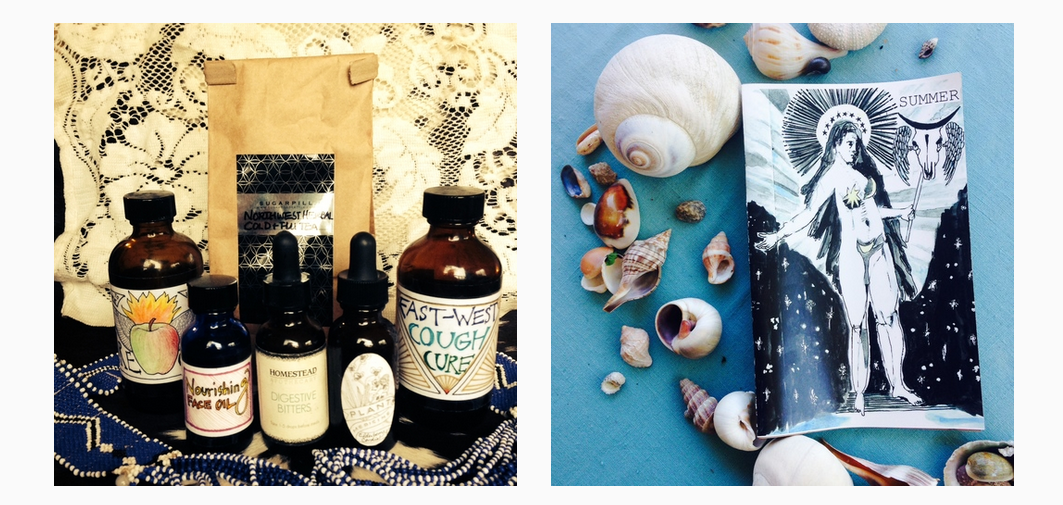
St. Pierre: Who is Nora Harrington, the energy behind the Medicine Chest?
Harrington: I’m also a gardener for an amazing gardening company called Red Twig Fine Gardening, and for a huge vegetable garden for a local island family. I’m so grateful to be spending so much time in the dirt! Realistically, running a small business, a little home and a gardening job, takes most of my time, but when I’m free, you can also find me practicing with my band Boobface, planning Lady Church, doing Tarot Spreads for lost souls and making meals with my friends. Right now I’m drinking yarrow, elderflower and ginger tea because I’m warding off a cold.
The deadline for signing up for the winter share is November 23rd! It arrives December 14th, so it will be a great holiday thing if people are thinking ahead. Last year, we had a lot of people send the subscription as a gift to their friends and family members. (One lady seriously bought 8 of them.)
The Island’s Winery Alliance to Host Labor Day Tours
August 31st, 2015
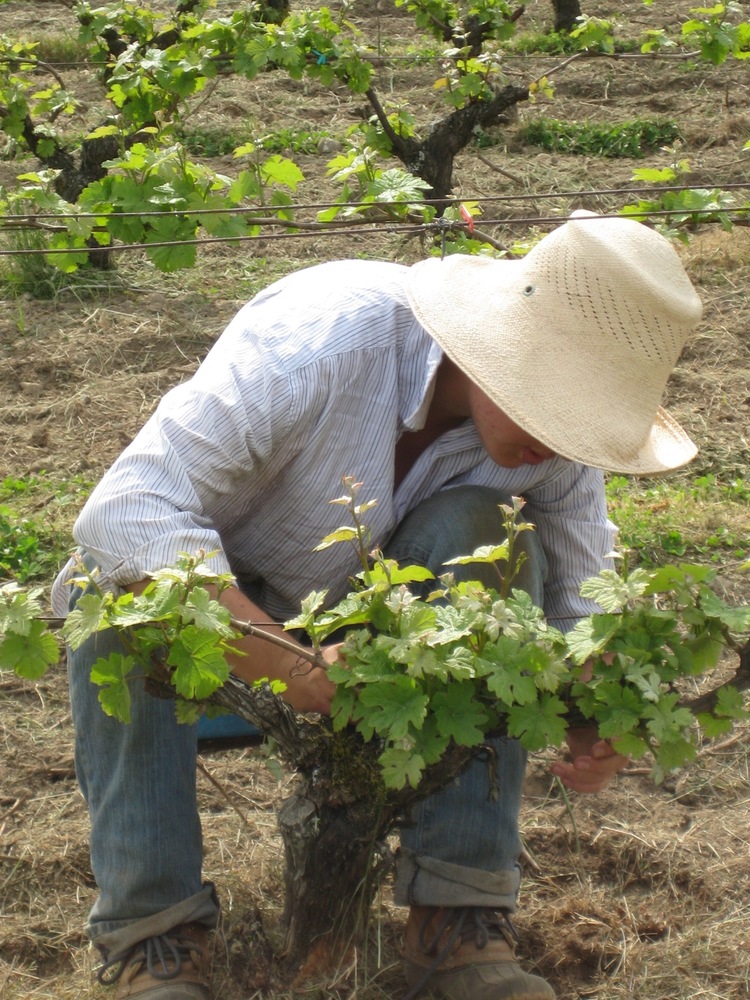
Contributed by Christine St.Pierre
This Labor Day, consider avoiding the wildfires and staying home to experience the Winery Alliance of Bainbridge Island’s Winery Tour Weekend, September 5–7, from noon to five o’clock PM. Seven wineries and one tasting room present wine procured from grapes grown within the island’s maritime climate as well as the east side of the Cascade mountains. These small and quaint wineries are earning big awards, and the vintners and viticulturists will be present during the tastings to welcome you and discuss all things vino. Take a loved one or two along for the ride, although avoid large groups as these tasting rooms are island-sized. After the clock strikes five, regroup with your friends and neighbors at one of the island’s restaurants to pour over your experiences from the day!
The Winery Alliance of Bainbridge Island (WABI), which began in 2003 at the hands of winemaking fanatics, consists of seven independent micro-wineries living right on our patch of rock. These wineries are run by their winemakers—individuals who are gifted with the ability and driven by the passion to create award-winning, vibrant handcrafted wine. Without relying on heavy machinery and thousand-barrel batches, these wineries operate through simply designed artisan systems, as well as uncomplicated, community-driven supply sources—like uber-local grapes—and neighborly distribution.
WABI consists of the following seven wineries that will be participating in the Winery Tour Weekend over Labor Day, as well as the Island Vintners tasting room:
Amelia Wynn Winery: This winery, founded in 2008, features Bordeaux, Rhone, and Northern Italian wines from grapes sourced from Eastern Washington’s aged vineyards.
Bainbridge Vineyards: With land stewardship dating back to 1928, this vineyard’s maritime bioregion—similar to that of France and Germany—works wonders for the seven acres of grape varietals grown on site at the Day Road Farm.
Eagle Harbor Winery: A commitment to honoring and furthering winemaking in Washington State has this winery producing new-age wine influenced by old world styles.
Eleven Winery: This off the cusp, sustainable (yes, green!) winery not only produces a variety of fantastic wine, but is run by wonderfully loving people who great things, like donate all after-tax profits to charity as well as sit-down food pairings with the winemaker.
Fletcher Bay Winery: Located in the happenin’ Coppertop Business Park, this winery features French Bordeaux-style wine that incorporates Italian Sangiovese and Spanish Tempranillo grapes.
Perennial Vintners: In 1997, Perennial Vintner’s (PV) winemaker began experimenting with winemaking, but it didn’t take him long to realize that most of winemaking truly happens in the vineyard, and so began the 2005 conception of (PV), producing estate-grown dry white wine from the underappreciated Melon de Bourgogne grape.
Rolling Bay Winery: After many years of playing and exploring within winemaking, a group of friends and wine enthusiasts settled in rocky Rolling Bay nearly a decade ago to handcraft fantastic wine as well as a stunningly beautiful tasting room, both of which have been considered one of the “Top 22 Tasting Rooms in Washington” by the Seattle Met.
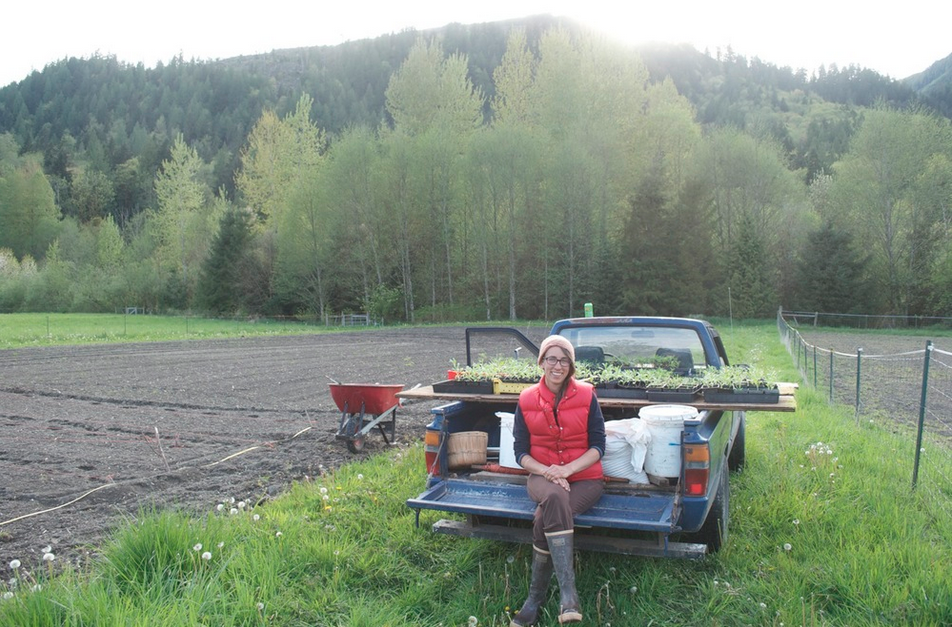
Peace and quiet enveloped me as I leaned against the doorframe of Sadie Beauregard and Paul D’Agnolo’s wooden yurt, one leg draped over the balcony’s edge, gazing down at the blueberry, raspberry, thimbleberry, and salmonberry bushes that the three of us had just harvested for the pie we would soon eat with their sweet neighbor Margot, a seventy year-old member of River Farm, an intentional community and cooperative farm located in Van Zandt, Washington. The two moved from farms on Bainbridge Island to the River Farm in December to begin a farm operation of their own, Foothills Flowers Farm—a far-off dream for so many.
Looking east from my perch in their elevated yurt, I took in a view of the Twin Sisters peaking over the forested foothills of the North Cascades, a beautiful backdrop to the resilient permaculture that the stewards of this Evergreen Land Trust have nurtured since a group of anarchists from Capitol Hill began the intentional community decades ago. Various walnut, apple, cherry, and plum trees provided shade for the rambunctious piglets romping around their grassy pasture. In the distance, the north fork of the Nooksack River carved along the property’s edge, encompassing the many small households, garden plots, pastures, trails, and groves within this Van Zandt paradise.
Seeking refuge from the early evening’s thick summer air, the three of us sat indoors, surrounded by textured bouquets of native flowers grown by the couple just a few hundred feet away, to be sold at various farmers markets. A John Prine record spun through the airwaves while we slow-cooked a blueberry and garlic scape-soaked salmon from the nearby rushing river, caught and gifted by a neighbor on the farm. This cooperative “what’s mine is yours” mentality is one of the many progressive concepts that drew Sadie and Paul into the sustainable farming community at various points in their life history.
The couple’s stories converged on Bainbridge Island while working for various farms and transformed into a shared desire to make the dream a reality: start a farming business, live sustainably, strengthen the farming community, and, ultimately, help to heal an ailing food system.
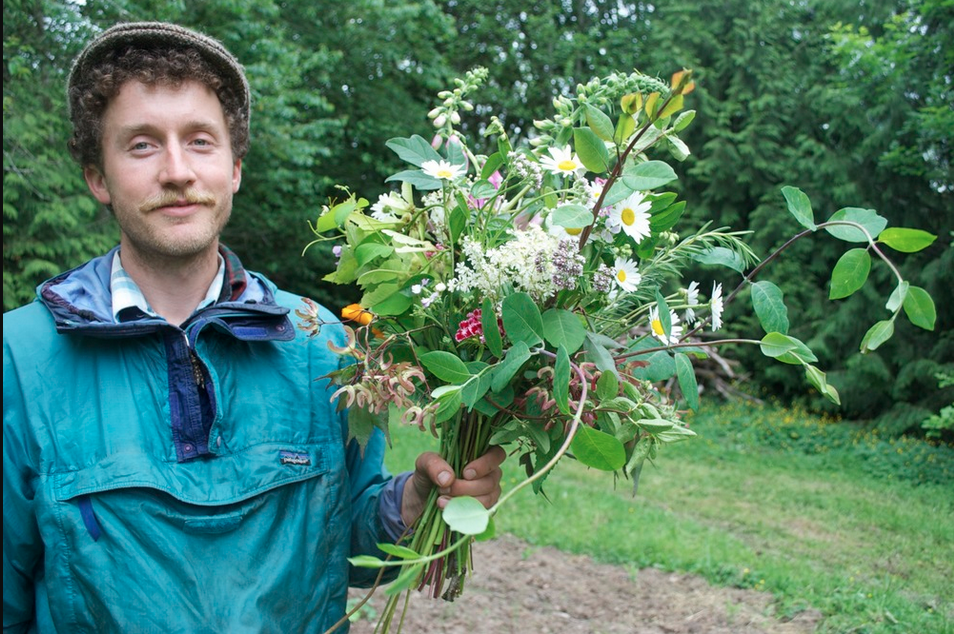
Paul, a Minnesotan, was turned off by his local farming community’s endless monocrop chemical agriculture that dominated the landscape, eventually farming on an island in Vermont’s Lake Champlain following a summer in Alaska. After an internship at Milwaulkee’s Growing Power, Paul traveled to California to work in the mountains looking for specific plants, eventually finding a home in Washington. Once in the Pacific Northwest, Paul wrote to his siblings in Minnesota, urging them to “quit their jobs, move west, buy a farm, climb mountains, catch fish, and be a family!” Within a year, the siblings were reunited, and five years later they continue to thrive. Paul expanded his farming experience, working at Seattle Tilth Farm Works in Auburn before eventually moving to the island to work with Symbiosis Food Cart and Bainbridge Island Farms, later moving to Butler Green. There, he met his “sweet Sadie beau” who has “been key in keeping [their] wandering way aligned with [their] hopes and aspirations toward owning a farm operation.”
Sweet Sadie, a moniker that so fully encompasses her tender nature, is a Vashon Island native who began this work five years ago after falling in love with farming during a year of urban gardening with AmeriCorps*VISTA in Seattle. After her service, Sadie took an internship at a small vegetable farm on San Juan Island, feeling like she “could farm forever.” She, like Paul, savors “the physical, hands-on nature of farming, as well as the opportunity to be outside and think creatively about growing, harvesting, and marketing.” Following her internship, Sadie was hired on at the island’s Persephone Farm where she “found flowers,” and flowers found her. There, she came to realize the importance and value of local flowers, seeing them akin to local food in that “conventional flowers are often grown with heavy chemicals by workers with poor working conditions and shipped hundreds of miles.” Eventually, her island farming career led her to work with both Heyday Farm and Butler Green, where she met Paul and found her best friend, a partner to build a farm with, to cook, hike, and laugh with “at all of the mistakes and triumphs we make along the way.”
With Paul’s brother operating Small Acres Farm nearby their now budding flower farm, Foothills Flowers, Paul and Sadie were able to partner their CSA operations for broader outreach. They have secured stands at the Fairhaven Farmer’s Market in Bellingham on Wednesdays, the Lynden market on Thursdays, and the Twin Sisters Market, which was created by fewer than ten local farms operated by young sustainable farmers, including Foothills Flowers.
This cooperative attitude is the tie that binds the farming community together. “We’re all broke, tired, struggling—but that’s what needs to change: the competitive attitude between farmers needs to turn into a cooperative one,” explained Paul. “The glimmers of light are where you and your buddies can help each other out—you can have a market where you don’t need to be there every week, or land you don’t need to own, and you can teach each other and share your secrets.”
Leaning against the open doorway across from me, Paul briefly paused, looking out across his garden. “Our food system is broken and we don’t have enough farmers to fix it.” This sharing of knowledge creates an important dialogue and helps strengthen community in a big way. Being at markets and conversing with your community about growing sustainably builds autonomy and excitement, and not just between farmers, causing everyone to care more about their natural surroundings.
Foothills Flowers Farm is built upon this appreciation and sense of place in life. The focus is on what bouquets do to you when you’re around them. “What I like about floriculture is that it really connects you to the season and makes you notice native plants with distinct flowers,” explained Paul, who described the bouquets produced by their farm as native flowers that are appropriate for climate and seasons, incorporating perennials, greenery, vines, and grasses to add texture. “They make you look at every plant and think, ‘How beautiful is that plant? Can we add that to a bouquet? Would we be able to make others see its beauty, too?’”
The answer is yes. Their unique and nontraditional flower arrangements are simple and breathtaking, featuring sweet pea, lupin, millet, wild rose, and thimbleberry blossoms, to name a few. Following a grant from the Bellingham Food Cooperative, which was used for marketing, supplies, insurance, and a rental truck arrangement with Cloud Mountain, another cooperative farm nearby, the two have taken Foothills Flowers to new, bold heights. Their success has stemmed from intense community support and the necessity for a healthier, stronger farming culture. Support your farmers, know your farmers—visit foothillsflowersfarm.com for more information about offers on events, weddings, and Sadie & Paul’s mission.
Contributed by Christine St. Pierre
Help Starvation Alley Farms Grow! We are!
May 22nd, 2015
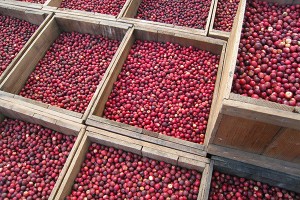
Campaign Ends May 28th!
Starvation Alley cranberry farm & juice company is raising funds for a high-volume juice press and bottling line that will help scale its juice production to 6X the current capacity. Over the past three years, Starvation Alley has become the go to source for Organic cranberries in the Northwest. As Washington State’s one-and-only certified organic cranberry farm, Starvation Alley is not only growing sustainable, local fruit, but is making it possible for other Northwest farmers to join them. They buy fruit from two neighboring farms (that are half way through the rigorous 3-year process of converting to organic) to produce a 100% pure unsweetened cranberry juice that is unlike anything else you can find on the market. Recently, Starvation Alley repaid it’s first Community Sourced Capital loan of $12,000 for a hydraulic juice press. This loan helped Starvation Alley grow to add 2 new farmers as suppliers and an additional 5 jobs local to the PNW. With the added production capacity possible from this next stage of funding the farm will be able to continue to increase its positive impact in the farming community.
Starvation Alley’s production kitchen is located on the Long Beach Peninsula in Southwest, WA. and produces about 8,000 gallons of cranberry juice a year. “Starvation Alley” is a historic road on the Peninsula that was home to hard-working oyster and cranberry laborers. They kept the name as an ode to those that came before them. We hope you’ll consider participating Find the campaign page through Community Sourced Capital here.
Starvation Alley’s mission is to support local farmer livelihood. They do this by paying great prices and aiding in the tough transition from conventional to organic growing. This loan will help them reach their next business milestone of adding an additional local farmer and creating a killer retail product that’s available to Northwest consumers.
Harbour Pub serves Starvation Alley cranberry juice exclusively and adds whole berries to its relishes and salad specials. Help us to help them!
Four Course Autumn Harvest Dinner
October 31st, 2014
BIMM Part 6 – The Growing Trend
June 30th, 2014
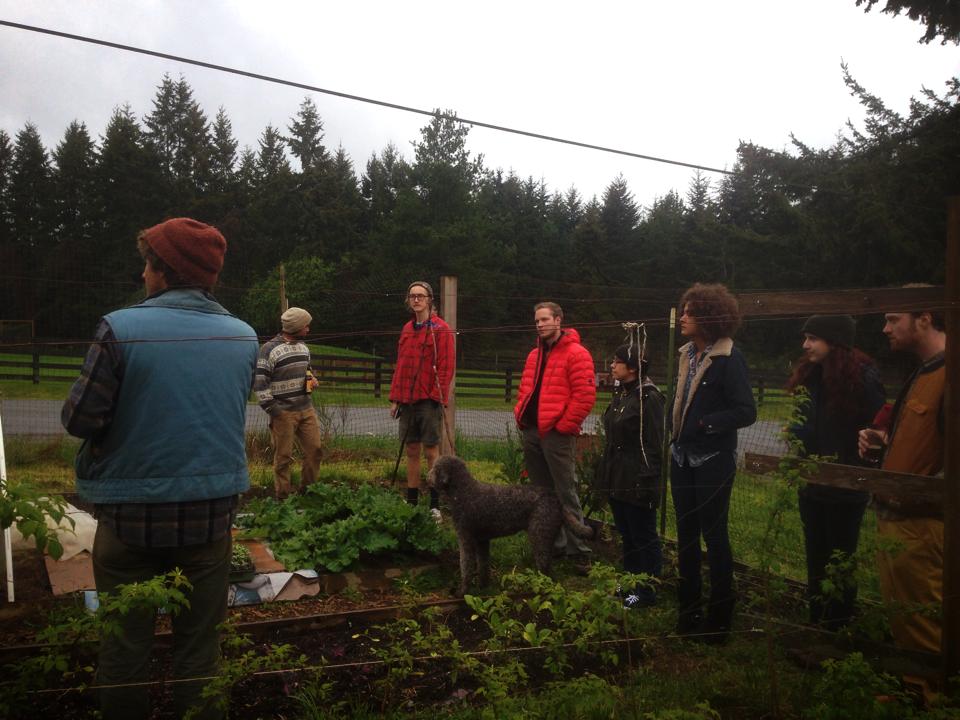
In an era shadowed by threats of environmental catastrophe, economic crisis, and social collapse, we are witnessing a mental shift in the next generation to whom the torch will be passed. By and large, the Millennials, born between 1980 and the new millennium, have been raised in a heavily consumer-centric society that has disassociated with the notion of living simply and sustainably off the land. As society wades deeper into these treacherous seas, communities have taken precautionary steps to keep themselves afloat.
Millennials are rising to the challenge by transitioning into a way of living that reclaims traditions long ago abandoned at the risk of being lost forever, traditions like homesteading, permaculture, fiber and textile production, natural medicine, and sustainable agriculture. As the price of produce and meat increases, so does the shift toward community gardening, urban farming, and agricultural education. Call it nostalgia for a romantically rustic way of life or call it necessity; either way, the growing trend in our generation, and in general, is growing organic food.
On this island, there is no shortage of small-scale farms with a focus on organic food that is grown in healthy rotation with the seasons. These farms, which foster deep community roots and innovative approaches to energy efficiency, such as natural irrigation and solar power, are staffed by pockets of Millennials with a passion for connecting to the earth and growing organic food that nourishes their bodies and the environment.
Nearly all farms on Bainbridge Island are supported by a crew of Millennials driven either by devotion or curiosity, and from what I’ve experienced, they’re really wonderful people—they’re my friends. With lives that can be mapped across the globe, these young farmers make up a colorful portion of this community, contributing music, art, and, well, food, that keep Bainbridge Island moving forward. With long, exhausting days in the sun and an intense summer push, they’re hard to find out on the town, but rather at intimate potlucks and picking sessions around a bonfire surrounded by fields of slow growing produce.
You’ve seen them bouncing between mud-caked work trucks and local restaurants with bins of fresh produce; you’ve smiled at them at the farmer’s market as they explain how to perfectly massage your kale for dinner tonight. They’re rugged and tan, with soil stained fingertips and disheveled hair hidden beneath a wool cap. They travel across the country with all of their belongings packed into their hatchback making stops at farms along the way. They conduct educulture programs aimed at introducing young children to the art of farming organic food and give property tours that showcase their happy plant and livestock production. They’re WWOOFers, interns, grantees, dreamers, spearheads; they are the future of a newfound relationship with food that just might save us all.
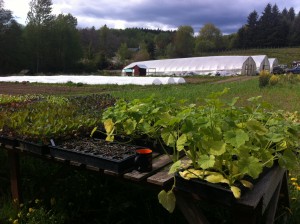
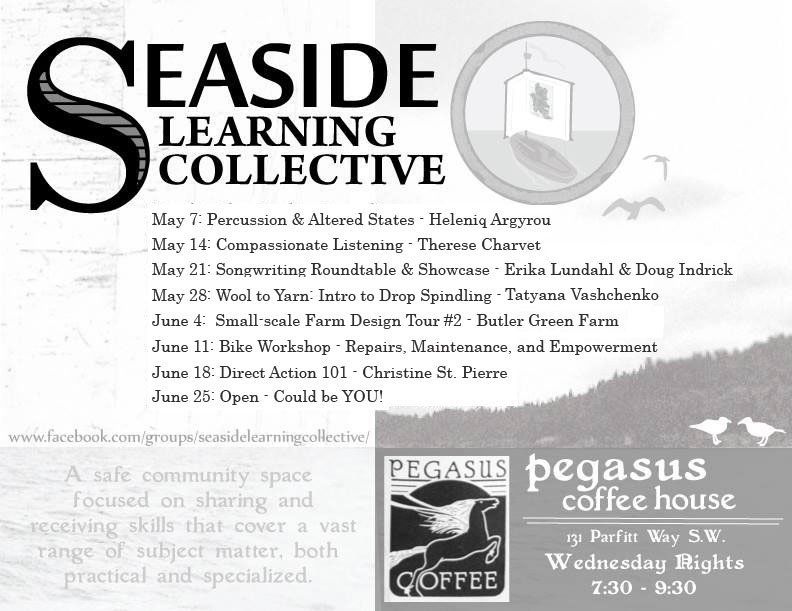
Bainbridge Island is populated by a wide variety of talented individuals, many of whom are deeply rooted in their community. Some are masters in craft trades, others in farming, arts, business, engineering—the list goes on. Each have developed expert skills, and each has the ability to share their skills within the community.
So, when offered Pegasus Coffee House for a location to organize a weekly event, I thought intensely about the direction I wanted to take it. The purpose was to unite the scattered collections of younger, like-minded people who were either brought here to pursue a passion or raised in the area and stayed because of a love for this magical place. Although drinking, games, and music are exciting ways to gather and create friendships, I wanted these events to amount to more than social hour. That’s why, with a little help from my friends, I created Seaside Learning Collective, a free school on Bainbridge Island.
At Seaside, your peers and friends are the teachers, giving lectures, leading discussions or workshops, and sharing their knowledge in order to promote community involvement. These classes demystify topics like homesteading, fermenting foods, or bicycle maintenance. By making these topics accessible, members of the community are more likely to participate at home, which can lower one’s living expenses, strengthen community bonds, and work toward a more sustainable environment and local economy.
The structure of free schools varies across the globe. Initially, fellow organizers and I drafted an intricate outline regarding donations, scheduling, and sign-ups. We researched global free schools to see how they ran. We planned websites with open discussion forums. We invented a money and sign-up system that would provide funds to the class teacher, the free school, and Pegasus. Just before launching, though, we scratched it all and trimmed it down to bare bones: a donation bag is passed around at the end of each class, and each class is open to any and all community members, regardless of advanced sign-up. Free coffee and tea are served during the class, and on special occasions the bar is open and alcohol may be purchased. At its heart, Seaside Learning Collective strives to bring people together for the purpose of advancing knowledge and promoting community.

Ryan Montella taking questions at Morales Farm
The months of March and April held some incredible classes hosted by young members of the community with a passion for their craft. Farmers from Butler Green Farm led a tour through Morales Farm, discussing design strategy and agriculture strategy. Another islander directed a hands-on fermentation and cultivation workshop with various work stations where attendants could make their own kombucha, yogurt, or kraut, and they brought the final products home! On the other end of the spectrum, we have hosted classes grounded in arts and intellect, such as a creative writing workshop or discussion on the importance of gratitude and giving.
The months of May and June are packed with exciting opportunities to participate in a folk songwriting roundtable, learn the basics of direct action and community organizing, experience another farm tour, create your own drop spindle and yarn, or even experience the ancient method of transcendental meditation through percussive drumming, led by a woman traveling from Greece to lead workshops in the greater Seattle area. We are very fortunate to be expanding, both in our teachers and attendants, to a broader audience.
While a class or two has been held at another location on the island for the purpose of a farm tour, most classes occur each Wednesday, from 7:30-9:30 at Pegasus Coffee House. I, along with the rest of Seaside Learning Collective, hope to see you there!
Help the Pub Help Educulture…Donate and Double the Money
November 4th, 2013

EduCulture is partnering with the Harbour Pub this autumn on a fundraising campaign to benefit the edible education programs. The Pub has a feature story about the work of EduCulture on their fall menu, encouraging patrons to contribute to supporting our work through the One Call for All campaign or directly through our non-profit organization.
For every dollar donated to EduCulture directly or through One Call for All during this fall campaign, the Harbour Pub will contribute a dollar, matching up to $7500 in contributions.
This opportunity to raise $15,000 will go a long way to build the needed infrastructure to further develop the edible education programs to meet their growing numbers of participating students and teachers.
We encourage you to consider making a tax-deductable contribution to EduCulture that can be generously matched by the Harbour Pub! (Please indicate “Pub” on your donation forms so they can better track these donations.
Time to Break Out the Sweaters!
September 25th, 2013
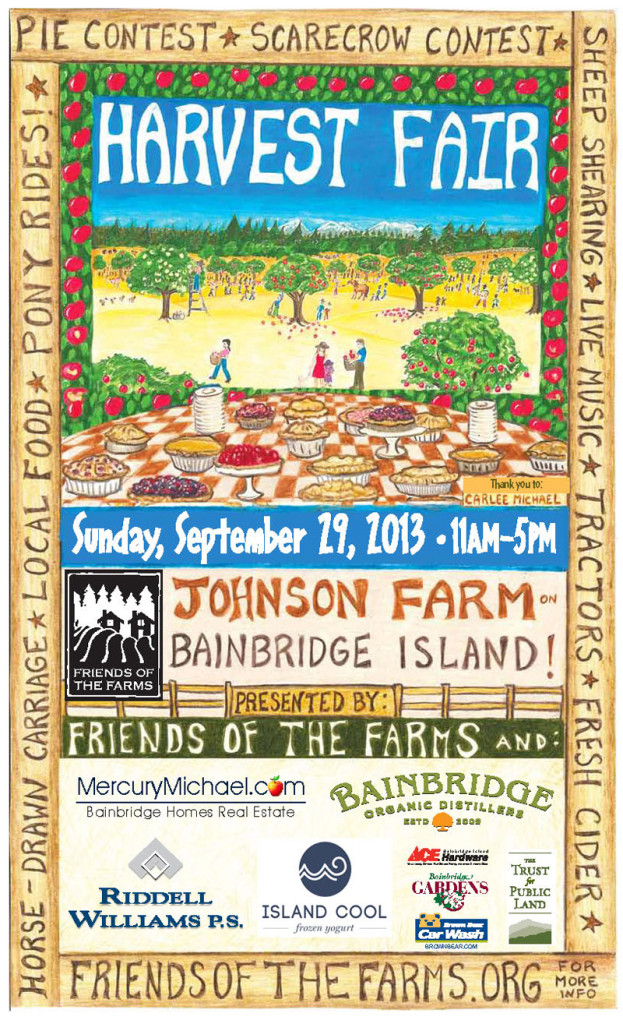
If you’re anything like me, you’re a total sucker for anything autumn. Pumpkin spice lattes, jack o lanterns, leaves changing color on the trees, the return of the regular Northwest downpour…it’s time to snuggle up in a warm blanket and take it all in.
The Harvest Fair is a beloved island tradition that helps everyone celebrate all the things that we love about fall. Sponsored by Friends of the Farm, a local nonprofit working to preserve the wonderful tradition of local farming, this annual event brings people of all ages together to enjoy a day filled with harvest celebration.
Come on down to Johnson Farm this Sunday, September 29, from 11 a.m. to 5 p.m., and take part in everything from apple cider-making to sheep shearing. Pony rides, pie contests, local music, and yummy food are some of the other activities everyone can enjoy. Local master gardeners will be on hand to discuss their craft and their food. For those of us that are old enough, a beer and wine garden awaits for tasting!
Donations to Friends of the Farm are welcomed upon entry. Donations to the organization are used to support the continuation of the Harvest Fair itself, as well as other work Friends of the Farm does throughout the year. Friends of the Farms works to provide access for local farmers to raise crops, repairs and maintains structures on farmland, and helps increase community awareness.
Shuttle rides to and from the event are available from both the ferry terminal, from Bethany Lutheran Church on High School, and from Strawberry Hill Park, also on High School Road.
Help celebrate the changing of the seasons! And let’s face it…no one is ever too old for a good old-fashioned tractor ride.
Please visit the Friends of the Farm website for more information and directions to Johnson Farm, at www.friendsofthefarm.org
